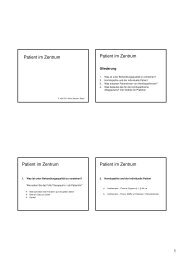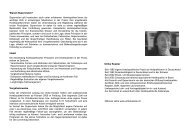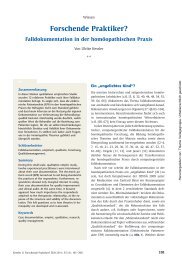Homeopathic case analysis 04-11-06 - Ulrike Kessler
Homeopathic case analysis 04-11-06 - Ulrike Kessler
Homeopathic case analysis 04-11-06 - Ulrike Kessler
You also want an ePaper? Increase the reach of your titles
YUMPU automatically turns print PDFs into web optimized ePapers that Google loves.
<strong>Homeopathic</strong> <strong>case</strong> <strong>analysis</strong><br />
A comparative methodological<br />
approach<br />
Samuel Hahnemann (1755 – 1843)<br />
„To cure mildly,<br />
rapidly certainly and<br />
permanently, choose,<br />
in every <strong>case</strong> of the<br />
disease, a medicine,<br />
which can produce<br />
itself an affection<br />
similar to that sought<br />
to be cured.“<br />
Organon, 6th edition, Introduction<br />
The <strong>case</strong> <strong>analysis</strong> „black box“<br />
Individual<br />
symptoms <br />
Case<br />
<strong>analysis</strong><br />
<br />
<strong>Homeopathic</strong><br />
remedy<br />
1
What happens in the black box?<br />
1 st step: Selection of symptoms<br />
Criteria?<br />
2 nd step: Arrangement of symptoms<br />
How?<br />
3 rd step: Repertorisation<br />
How?<br />
4 th step: Remedy selection<br />
What is your approach?<br />
• How were you trained?<br />
• Are you trained in more than one <strong>case</strong><br />
<strong>analysis</strong> approach?<br />
• How are you dealing with the differences<br />
between the approaches?<br />
Case analyis: the Dilemma<br />
<br />
Case <strong>analysis</strong><br />
Method 1 <br />
Remedy 1<br />
Individual<br />
Symptoms <br />
Case <strong>analysis</strong> <br />
Method 2<br />
Remedy 2<br />
<br />
Case <strong>analysis</strong> <br />
Method XY<br />
Remedy XY<br />
2
The Case Analysis Dilemma<br />
• Does it matter which remedy is chosen?<br />
• Is homeopathic <strong>case</strong> <strong>analysis</strong> just another<br />
ritual?<br />
Does a <strong>case</strong> <strong>analysis</strong> method<br />
exist which is always right?<br />
• No!<br />
• The method must be homeopathic, which<br />
means: it fits the individual situation!<br />
How do we know that the<br />
approach chosen fits the<br />
individual situation of the<br />
patient?<br />
• The patient tells us!<br />
• We need to listen!<br />
3
Hahnemann: „… Keeping silence himself<br />
he allows them to say all<br />
they have to say, and<br />
refrains from interrupting<br />
them…“ Organon § 84<br />
Footnote: „Every interruption<br />
breaks the train of thought<br />
of the narrators, and all<br />
they would have said at<br />
first does not again occur to<br />
them in precisely the same<br />
manner after that.“<br />
Are there other criteria?<br />
Meta-Analysis<br />
of different approaches to<br />
homeopathic <strong>case</strong> <strong>analysis</strong><br />
Meta-Analysis:<br />
points to be discussed<br />
• Theoretical basis<br />
• Advantages + Disadvantages<br />
• Example: Case # 501<br />
4
Case<br />
• Woman, born 1966, Migraine and<br />
menstrual complaints<br />
• First interview May 2003<br />
1 st step: Selection of symptoms<br />
Criteria<br />
• What does the patient report?<br />
• What do we really know – without our<br />
interpretation?<br />
• What is peculiar to this patient and her<br />
complaints?<br />
• What else could be important?<br />
1 st step: Selection of symptoms<br />
Case<br />
• Pregnant from men who refuse to have children<br />
• Abortion from negative emotions<br />
• Multiple abortions in first months, several curretages<br />
• Uterus „battered“ – many scars<br />
• Black menses<br />
• Rebellious, fights, loves to contradict<br />
• Changeable mood<br />
• Diversion / Occupation amel.<br />
• Back pain extending upwards<br />
• Head pain alternating with back pain<br />
5
2 nd step: Arrangement of symptoms<br />
• First things first!<br />
• What are the most striking and<br />
characteristic symptoms?<br />
2 nd step: Arrangement of symptoms<br />
1. Black menses<br />
2. Abortion from negative emotions<br />
3. Multiple abortions, first months<br />
4. Rebellious, fights, loves to contradict<br />
5. Diversion / Occupation amel.<br />
6. Back pain extending upwards<br />
3 rd step: Repertorisation<br />
• Choice of rubrics = Translation of the<br />
words of the patient into the language of<br />
the repertory<br />
• Repertorisation =<br />
mathematical – statistical procedure<br />
6
3 rd step: Repertorisation (Rubrics)<br />
3 rd step: Repertorisation (Totality)<br />
4 th step: Remedy selection<br />
• The repertorisation can only suggest a<br />
choice of remedies<br />
• Rubbish in rubbish out<br />
• Final selection: „The authority is the<br />
Homoeopathic Materia Medica“ (Clarke, Prescriber, preface)<br />
7
4 th step: Remedy selection<br />
• Which remedy is „homeopathic“ to this<br />
<strong>case</strong>?<br />
Materia medica study of Lachesis, Nux<br />
vomica, Apis, Sepia, Cyclamen, Ferrum… etc.<br />
• Is there an alternative, a short cut?<br />
Meta-Analysis:<br />
the approaches<br />
1. Hahnemann and Boenninghausen<br />
2. Miasmatic approach<br />
3. Clinical approach<br />
4. Kent and the consequences<br />
1. Hahnemann and Boenninghausen<br />
(1755 – 1843) (1785 – 1864)<br />
The „classical“ approach<br />
Further developped by:<br />
– Cyrus Maxwell Boger: A Synoptic Key<br />
– Contemporary German homeopaths, like Henning Gypser, Bernhard Möller, Thomas<br />
Genneper, Andreas Wegener and others<br />
8
Theoretical basis<br />
• Hahnemann: SRP-Symptoms<br />
„In this search for a homœopathic specific remedy, (…) the more<br />
striking, singular, uncommon and peculiar (characteristic) signs<br />
and symptoms (…) of the <strong>case</strong> of disease are chiefly and most<br />
solely to be kept in view.“ (Organon, aphorism 153)<br />
• Boenninghausen: Complete Symptoms<br />
Quis? Quid? Ubi? Cur? Quamodo? Quanto? Quibus auxilis?<br />
Who? What? Where? Why? In what manner? When? With what?<br />
advantages + disadvantages<br />
Only symptoms which are clinically<br />
confirmed<br />
No interpretation reliable!<br />
Limited range of remedies – about 125<br />
Chronic-miasmatic background is not taken<br />
into consideration<br />
Mind symptoms are not considered<br />
2. Miasmatic approach<br />
• Hahnemann, Chronic diseases<br />
• Further developped by:<br />
– J. Compton-Burnett (1840 – 1901)<br />
– J.H. Allen (1854 – 1925)<br />
– John H. Clarke (1853 - 1931)<br />
– German homeopaths: Gerhard Risch / Yves Laborde<br />
– Etc.<br />
9
Theoretical basis<br />
• Miasmatic Signs<br />
• Family history<br />
• Individual <strong>case</strong> history<br />
• Toxicology<br />
advantages + disadvantages<br />
Consideration of chronic-miasmatic<br />
background<br />
Limited range of remedies – about 80-<br />
140<br />
SRP-Symptoms not considered<br />
Mind-Symptoms not considered<br />
3. Clinical approach<br />
• Samuel Hahnemann, e.g.<br />
Organon aphorism 73 and others<br />
• Further developped by:<br />
Georg Heinrich Gottlieb Jahr (1800<br />
– 1875), Samuel Lilienthal (1815 –<br />
1891), Henry N. Guernsey (1817 –<br />
1885), H.C. Allen (1830 – 1909),<br />
Eugene B. Nash (1838 – 1917),<br />
William Boericke (1849 – 1929),<br />
W.A.Dewey (1858 – 1938), R.S.<br />
Phatak, German homeopaths: Karl<br />
Staufer, Erwin Schlüren, Gerhard<br />
Köhler and many others<br />
10
Theoretical basis<br />
• Key notes, SRP-symptoms<br />
• Causation<br />
• Genius epidemicus<br />
• Clinical indication<br />
• Organotropy<br />
• Etc.<br />
advantages + disadvantages<br />
Quick and reliable, if<br />
– Clearly defined beginning / causation, and<br />
– Symptoms in different levels<br />
„Last resort“ in one-sided <strong>case</strong>s<br />
Huge range of remedies – about 1500<br />
Danger of „homeopathic allopathy“<br />
Limited range of application<br />
Reliability of information in MM can be ??<br />
Case: Clinical approach<br />
E.g. Lilienthal, Homoeopathic Therapeutics,<br />
Chapter„Miscarriage/Abortion“+„Uterus, Diseases of“:<br />
Aletris farinosa:<br />
„Habitual tendency to abortion in feeble persons of lax fibre and anemic<br />
condition, even after hemorrhage has set in; weight in uterine region, tendency<br />
to prolapsus uteri; general weakness of mind and body; weak from sickness or<br />
defective nutrition”<br />
„Prolapsus uteri from muscular atony; leucorrhea from loss of fluids or defective<br />
nutrition; debility from protracted illness; obstinate indigestion, the least food<br />
distresses the stomach; fainting; with vertigo; (…) sterility from uterine atony;<br />
heavy, dragging pain about the hips; profuse, painful and premature menses;<br />
profuse leucorrhea.“<br />
<strong>11</strong>
Case: Clinical approach<br />
Lachesis:<br />
„Nymphomania; uterine region feels swollen, will bear no contact;<br />
bearing - down pains; uterine and ovarian pains relieved by a flow of<br />
blood; pain like knife thrust into abdomen; uterus feel as if os were<br />
open; redness and swelling of external parts, with discharge of mucus;<br />
swelling, induration neuralgia, suppuration, etc., of left ovary; pain in<br />
coccyx when sitting down, as if sitting on something sharp; trembling of<br />
legs; cervix very sensitive to touch, bleeding easily.<br />
Nux vomica:<br />
„Every pain produces a desire to defecate and to urinate; frequent desire to<br />
urinate, with burning and scalding when urinating; constipation, has<br />
large difficult stools or small and frequent ones, with pain in ano;<br />
irritable, dreads being moved, pains across uterus.”<br />
“Feeble, dyspeptic patients with pain in back, bearing down towards<br />
sacrum and pressing pain over hips; burning heaviness and sticking in<br />
uterus; hardness and swelling of os; prolapsus uteri from straining or<br />
lifting; sight leucorrhea, which is foetid, staining yellow; great debility of<br />
nervous system with hyperaesthesia; wants to sit or lie down; internal<br />
swelling and burning of vagina like a prolapsus; inharmonious action of<br />
intestines.”<br />
Case: Clinical approach<br />
Sepia:<br />
„Miscarriage from fifth to seventh month; fullness and pressure of blood<br />
to head and chest; feeling of heaviness in abdomen and sense of<br />
weight in anus like a heavy ball, piles, flushes of heat, with faintness<br />
and momentary attacks of blindness, especially in a warm or close<br />
room; MOTIONS OF FOETUS ARE HARDLY TO BE FELT; painful<br />
sensation of emptiness in pit of stomach; induration of os and cervix<br />
(Aur., Con.); constipation”<br />
“Prolapsus uteri et vaginae from atonic relaxation of the ligamentous<br />
and vaginal supports of uterus, relieved by lying down or crossing legs;<br />
worse when sitting up, standing or walking, which causes bearing down,<br />
heat, goneness, backache and fainting; gone sensation in pit of<br />
stomach, about noon, relieved by eating and lying down; induration of<br />
neck of uterus; dropsy of uterus; tenderness of genitals to touch; venous<br />
passive congestion, chronic metritis, displacements, especially<br />
retroversion; frequent bloody discharges between menses, especially<br />
after intercourse; pressure at genitals, as if everything would protrude;<br />
(...) want of natural heat, aversion to open air; burning in region of<br />
cervix, worse by touch; (...) bearing down in pelvis and sense of weight<br />
in anus like a heavy bal. Chronic subinvolution.”<br />
Case: Clinical approach<br />
Helonias dioica:<br />
„Threatened abortion from atonic condition, especially in habitual<br />
abortion; slightest overexertion or irritating emotion tends to cause loss<br />
of foetus; useful for many of the sequelae of miscarriage.”<br />
“Profound melancholy; deep, undefined depression, with a sensation or<br />
soreness and weight in womb; consciousness of a womb; dragging<br />
weakness in sacral region, with prolapsus uteri and ulceration of cervix;<br />
discharge constant, dark, badly smelling; flooding on lifting a weight,<br />
and on least exertion; face swollen, having an expression of suffering;<br />
great vaginal irritation; uterus low down, or protruding, fundus tilted<br />
forward; the finger passes with difficulty between os and rectum;<br />
leucorrhea, with atony and anemia; aphthae on labia; intense itching of<br />
vulva; anemia, atony, often amenorrhoea; albuminous urine; great<br />
debility and drowsiness; tired aching feeling and some burning in back<br />
and legs; amel. while doing something.”<br />
Further study in the Materia Medica!<br />
12
Case: Clinical approach<br />
E.g. Repertory-Search„Female / Abortion“<br />
Case: Expert Analysis<br />
4. Kent and the consequences<br />
• James Tyler Kent<br />
(1849 – 1916)<br />
• T.F. Allen, C.M. Boger, S.R.<br />
Phatak, P. Sankaran<br />
• Pierre Schmidt (1894 – 1987)<br />
Jost Künzli v. Fimmelsberg,<br />
W. Klunker<br />
• George Vithoulkas<br />
• Etc.<br />
13
Theoretical basis: Kent<br />
• „Disease is caused by wrong thinking“ <br />
Mind symptoms emphasized<br />
• Remedy pictures<br />
• Common symptoms vs. Local symptoms<br />
Künzli:<br />
Hierarchy of symptoms:<br />
I. SRP symptoms<br />
II. Mind symptoms<br />
III. Common symptoms<br />
IV. Causation<br />
IV. Accompanying symptoms<br />
V. Local symptoms<br />
Vithoulkas:<br />
• Strong emphasis on<br />
mental and emotional<br />
symptoms Essences<br />
• Three-level-model:<br />
hierarchy mental –<br />
emotional – physical<br />
• Underlinings instead of<br />
SRP-Symptoms<br />
14
advantages + disadvantages<br />
• Kent:<br />
Remedy pictures easy to remember<br />
Patients today observe their mental symptoms<br />
better than the physicals<br />
Reliability of mind symptoms in the materia<br />
medica and repertory ??<br />
Interpretation +<br />
Easy, but not too reliable<br />
advantages + disadvantages<br />
• Künzli:<br />
SRP-symptoms first<br />
Only clearly stated mind symptoms<br />
Less interpretation, more reliable<br />
Statistical problems of the repertory<br />
Only about 4-500 out of 2000 remedies<br />
covered, „Polychrest“-Homeopathy<br />
advantages + disadvantages<br />
• Vithoulkas<br />
Fascinating, modern and easy to grasp<br />
Essences one-sided and not very reliable<br />
Essences only known from about 100 remedies<br />
Interpretation +++<br />
„Constitutional prescription“, „Types“<br />
15
„Is there a Helonias-“Type?“<br />
E.g. Vermeulen, Synoptic II:<br />
• "It is adapted to two great classes of women; for those who are tired out from doing nothing and<br />
need some new and untried form of excitement to keep them going; and for those who are all<br />
worn out from overwork, so used up that they can neither rest nor sleep." [Pierce]<br />
• Better when [KEPT] BUSY; by [mental] diversion [and not thinking of her disease].<br />
• "Helonias suits the wilted, depressed sophisticated woman, who constantly complains to her<br />
husband and children and doesn't even have the energy to talk or get excited about anything,<br />
because her head is absolutely 'empty' but who, as soon as a friend visits, can talk and gossip for<br />
hours without a trace of fatigue. When she then resumes her complaints in the evening about<br />
being tired, she becomes irritable and tolerates no criticism when her husband remarks how able<br />
she was to talk and laugh that afternoon." [Voisin]<br />
• Intolerance of contradiction or consolation.<br />
• Discontented and censorious; sits the whole day, finding fault with everyone.<br />
• "Irritable; could not receive any suggestions in relation to any subject; all conversation was<br />
unpleasant." [Hale]<br />
„Is there a Helonias-“Type?“<br />
• Consciousness of kidneys and uterus. "Feels uterus<br />
move when she moves.“ "Continual consciousness of a<br />
womb, it so sore and tender. Now this condition is often<br />
found at the age of puberty, during pregnancy and after<br />
labour, and here Helon. is indeed a blessing." [Nash]<br />
• Bad effects of abortions and miscarriages. Prevents<br />
miscarriages.<br />
• "Its principal usefulness is in those <strong>case</strong>s which arise from<br />
a uterine atony, which can not hold on to the fruit of<br />
conception, but allows it to escape at the periods<br />
coinciding with the previous menstrual flux; or when the<br />
slightest overexertion, or irritating emotion, tends to cause<br />
loss of the foetus. (..)." [Hale]<br />
• Introduced by Hale, not proven by Hahnemann, not<br />
mentioned by Boenninghausen<br />
• Complete Repertory: 713 symptoms.<br />
Case: Remedies, FU‘s<br />
• May 2003: Helonias 200c<br />
• October 2003: Helonias 200c<br />
Pregnant<br />
• December 2003: Helonias 6LM<br />
• March 20<strong>04</strong>: Sepia 200c (self medication)<br />
• May 20<strong>04</strong>: Helonias 200c<br />
Serena June 20<strong>04</strong> (Cesarean)<br />
• August 20<strong>04</strong>: Helonias M<br />
16











